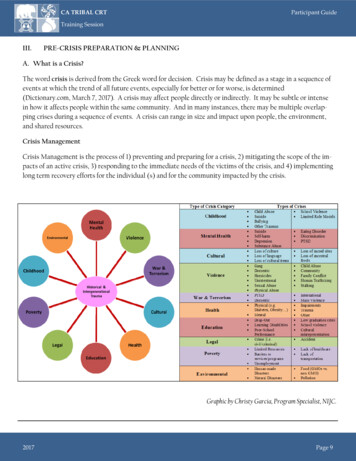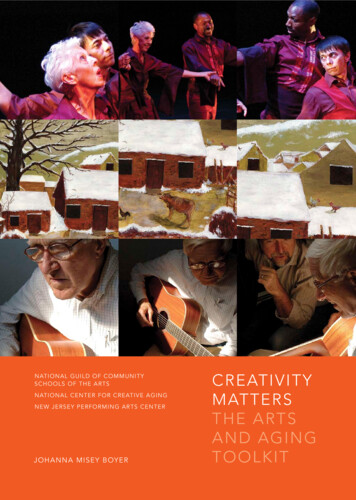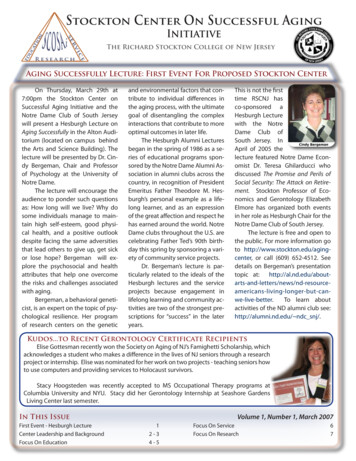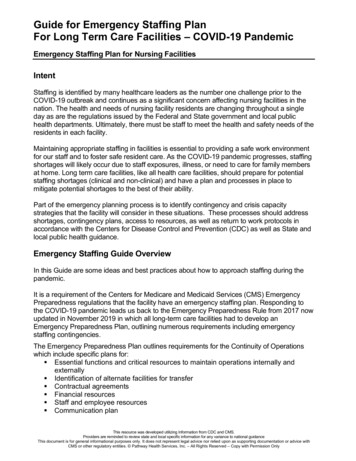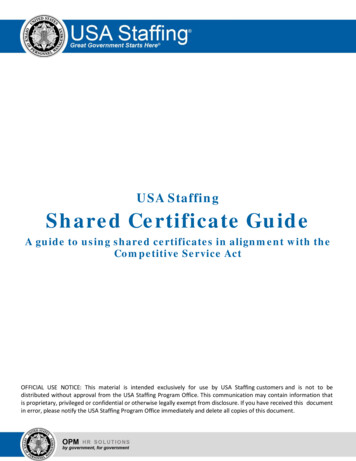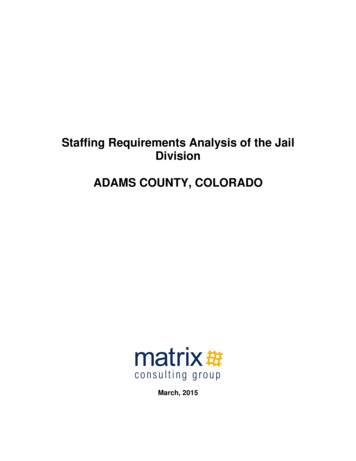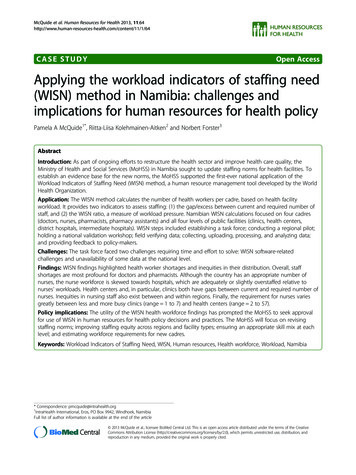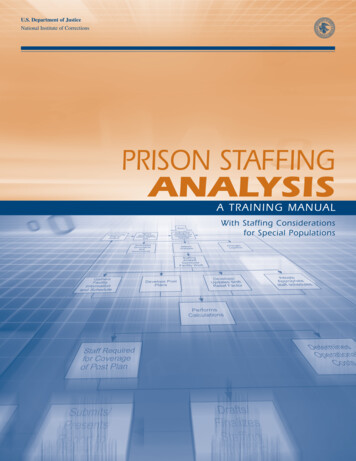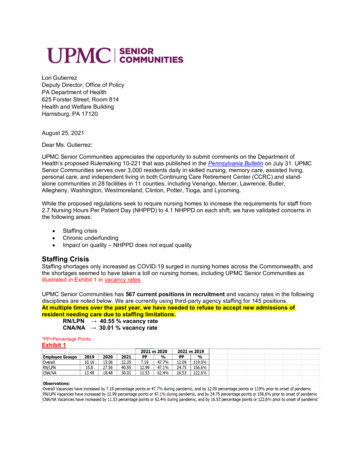
Transcription
Lori GutierrezDeputy Director, Office of PolicyPA Department of Health625 Forster Street, Room 814Health and Welfare BuildingHarrisburg, PA 17120August 25, 2021Dear Ms. Gutierrez:UPMC Senior Communities appreciates the opportunity to submit comments on the Department ofHealth’s proposed Rulemaking 10-221 that was published in the Pennsylvania Bulletin on July 31. UPMCSenior Communities serves over 3,000 residents daily in skilled nursing, memory care, assisted living,personal care, and independent living in both Continuing Care Retirement Center (CCRC) and standalone communities in 28 facilities in 11 counties, including Venango, Mercer, Lawrence, Butler,Allegheny, Washington, Westmoreland, Clinton, Potter, Tioga, and Lycoming.While the proposed regulations seek to require nursing homes to increase the requirements for staff from2.7 Nursing Hours Per Patient Day (NHPPD) to 4.1 NHPPD on each shift, we have validated concerns inthe following areas: Staffing crisisChronic underfundingImpact on quality – NHPPD does not equal qualityStaffing CrisisStaffing shortages only increased as COVID-19 surged in nursing homes across the Commonwealth, andthe shortages seemed to have taken a toll on nursing homes, including UPMC Senior Communities asillustrated in Exhibit 1 in vacancy rates.UPMC Senior Communities has 567 current positions in recruitment and vacancy rates in the followingdisciplines are noted below. We are currently using third-party agency staffing for 145 positions.At multiple times over the past year, we have needed to refuse to accept new admissions ofresident needing care due to staffing limitations.RN/LPN 40.55 % vacancy rateCNA/NA 30.01 % vacancy rate*PP Percentage PointsExhibit 1
COVID-19 exposed existing nursing home staffing shortages and turned these challenges into a fullblown crisis with enhanced unemployment benefits and competing job opportunities also playing a role.While COVID-19 vaccines have brought relief inside nursing homes as resident and staff infections havedeclined, 1 they have also created another staffing challenge for administrators concerned that workerswill walk away if they are required to get the vaccine, further exacerbating the shortfall. 2 Not requiringsimilar mandates for other levels of health care providers, such as hospitals or physician offices, willworsen the “flight” from nursing facilities because there are other places also suffering from the staffingshortages and no shortage of other opportunities elsewhere for these same pool of workers. Weacknowledge providers of health care and nursing services are in constant and ever-more expensivecompetition for the same small cohort of eligible and interested workers. Mandating a 50 percentincrease in nursing home staffing will have broad and detrimental effects across all health caresectors.DOH proposes the implementation timeline for this package to be effective immediately upon publicationas final; however, the shortage of available workers to achieve compliance with a mandate could lead tochallenges with access to nursing home care, particularly in rural areas.Therefore, we recommend DOH allow nursing facilities at least one year from publication of the finalregulations to comply with any increase in staffing minimums before citations for non-compliance can beissued. DOH should clarify: 1) situations in which exceptions are necessary; 2) what happens when afacility is not able to comply.We also recommend the Commonwealth take substantive and meaningful action on addressing theworkforce shortage consistent with PA Department of Aging’s Blueprint for Strengthening Pennsylvania’sDirect Care Workforce. 3Furthermore, the first part of the DOH regulation package only addresses definitions and staffingminimums. Subsequent packages, including new minimum staffing ratios, are forthcoming. As a result, weare concerned that releasing these packages in a piecemeal fashion may lead to confusion by providers,regulators, and the public. There could also be significant discrepancies and lack of clarity utilizing thisstrategy.Additionally, we request that DOH not implement any parts of the regulatory package until all parts areissued and there is a minimum of a 30-day public comment period on the entire regulatory packagefollowed by a full regulatory review process.Chronic underfundingAs the primary financiers for short-and long-term nursing home stays respectively, the payment rules ofMedicare and Medicaid will play crucial roles in realizing a new vision – post COVID – for the appropriateservices and settings for the care nursing homes currently provide.Nursing homes in one of the nation’s oldest states have not received any increase in state Medicaidprogram funding – the largest payer of nursing home care – for the past seven years even thoughinflation for health care has increased dramatically.Even the best nursing home providers cannot provide the highest quality care with diminishingfunds. As evidenced by a LeadingAge Pennsylvania statistical analysis of the industry, the cost of carehas risen by 33 percent while Medicaid rates have only increased by 1percent, resulting in an averageannual loss to nursing facilities of 17,000 per resident.Sustained Drop in Covid-19 Nursing-Home Deaths Points to Vaccinations - WSJBiden Nursing Home Vaccine Mandate Expected to Devastate CNA Recruitment, Retainment - Skilled Nursing News3LTCC Blueprint for Strengthening Pennsylvania’s Direct Care Workforce APR19 (pa.gov)12
The status quo financing of nursing homes in Pennsylvania is not sustainable. Unless thereimbursement rates paid by the Medicaid program are brought more in alignment with the costs ofproviding high quality care in a safe manner, providers will be unable to care for the Commonwealth’smost vulnerable residents and already strained family caregivers will be that much more burdened.While DHS has made some projections of costs, there is no guarantee that these funds will be included inthe budget, or that increased payments will be made to nursing facilities by the CommunityHealthChoices Managed Care Organizations. Additionally, there is no recognition by DOH that providersmay need to raise private-pay rates, thereby increasing the numbers of individuals that spend downassets and add to the Medical Assistance spending.We fervently believe that the reimbursement methodologies and operating parameters of states cited bythe DOH, including Florida, Alaska, Idaho, Oregon, and Utah, must be compared in addition to theirstaffing requirements. Comparing staffing requirements without also comparing both operational andreimbursement structures is disingenuous and myopic.For example, in its proposal, DOH cites legislation in Connecticut that, if passed and enacted, willestablish a minimum requirement of 4.1 direct care nursing hours for 209 nursing homes. 4 The RhodeIsland Senate also recently passed a bill, which, if enacted, will require its 78 nursing facilities to provide aminimum daily average of 4.1 hours of direct nursing care per resident, per day. 5It is important to underscore that both Connecticut and Rhode Island joined North Carolina andOregon to boost Medicaid nursing home rates last year. For example, Connecticut received 15percent Medicaid boost. Initially, state officials announced a 10 percent rate increase for providers. It lateradded another five percent boost after calling on the state to do more to prevent a financial collapse ofthe sector. 6 7Moreover, Pennsylvania is one of only a handful of states whose Medicaid program does notprovide reimbursement for personal care and assisted living facilities. Much analysis has been doneon the impact of funding assisted living in Pennsylvania. 8 By reexamining this issue, the Commonwealthshould be able to both decrease its overall funding for seniors and allocate dollars and staffing where it isneeded – caring for the disproportionate share of residents above the age of 80, who are frail and havechronic, preexisting conditions in skilled nursing facilities.Managed care organizations now handle most of the Commonwealth’s Medicaid population, and allowingthese organizations the flexibility to provide funding for care in the best available setting is actuarily soundpolicy. Additionally, caring for residents in primary private assisted living accommodations will result in: decreased infection transmissiondecreased agitationdecreased the need for medicationincreased in satisfaction among resident and familyNHPPD does not equal qualityAt UPMC Senior Communities, our care is team-based and a lack of flexibility to provide staffing based onthe acuity of individual patient needs would jeopardize safe patient care. To truly commit to patient safety– always the number one priority – our care team needs to be empowered with flexibility to determineappropriate staffing for the needs of their patients. The quality of a resident’s life is significantlyaffected by care that is competent, compassionate, and responsible.Raised S.B. 1030, General Assembly Reg. Session (Conn. 2021).Nursing Home Staffing and Quality Care Act, S.B. 0002, General Assembly Reg. Session (R.I. 2021).6CT hospitalizations continue to fall, Lamont pledges more money for nursing homes (ctpost.com)7Opinion/Gifford: Bill poses burdens to RI's nursing homes rch-data/alpc45
UPMC Senior Communities encourages the Department of Health to promote the active engagement withboth medical directors and adjunct provider teams in establishing appropriate staffing recommendations.Moreover, Pennsylvania’s approach to funding various levels of care and the acuity of skilled nursingresidents must be considered when analyzing staffing requirements and reimbursement. Many skillednursing residents are only in skilled facilities because of the limitations of the Medicaid program and thelimited financial means therein. The care hours required by residents’ needs and resident census changedaily and even hour by hour. As more residents are diagnosed with dementia or other cognitivelyimpaired related diagnosis – 14 percent by 2025 – facilities should have the flexibility and resources tostaff adequately based on needs specific to this population. 9Placing all residents into a single staffing requirement, no matter the number, is a failure torecognize this fact for the purpose of simplicity. 10 The PA Bulletin cites an integrated literature reviewof the relationship between staffing and quality outcomes in nursing homes. The study pronounces theimportance of considering staffing composition and the clear need to further evaluate the issue since thereviewed studies have not clearly defined the relationship between differing levels of nurse-staffing skillmix and specific structural, process, outcome, and composite indicators of quality. Moreover, it statesthere is not enough information to determine a specific staffing ratio.As a matter of fact, the conclusion 11 states: Nurse staffing is a key factor to improve QOC and QOL forNH residents. Original studies of 28 articles during the past 10 years were reviewed. The findingsreported inconsistent findings of the relationship between nurse staffing and resident outcomes. Furtherresearch is needed, including investigating the relationship between nurse staffing and QOC or QOL anddeveloping integrative review papers to have a higher level of evidence that can be used for determiningoptimized nurse staffing levels.We recommend that any decisions about staffing consider the broader issues 12, including: the complexity and acuity of a facility’s population; the functional level of residents and services required; creating consistent work schedules that are flexible to accommodate the changing needs of theresidents along with improving consistent communication and documentation regarding the careneeds of residents; the existence of staffing shortages for some types of staff in some geographic locations, andtemporary staffing shortages due to such events as employee illness or termination; defining and including other categories of caregivers, such as medication aides, feedingassistants, restorative aides, family members, and activities professionals; being more flexibleand to allow nimble response to the market dynamics; the quality, competence, and engagement of staff leadership and supervision; addressing adequacy of training and skills development, and the career and educational development of staff (especially among newly licensed nurses).Moreover, we endorse building on existing relevant regulations, such as the F838 Facility Assessmentthat was included in the 2016-2019 updated OBRA regulations, instead of creating new state mandates. 13Given DOH nursing facility regulations and several new tools from Centers of Medicare and MedicaidServices (CMS) that include Payroll Based Journal (PBJ), which is a verifiable set of staffing data, DOHsurveyors already have substantial authority and insight to oversee staffing in nursing heimers-facts-and-figures-2019-r.pdfShin JH, Bae SH. Nurse staffing, quality of care, and quality of life in US nursing homes, 1996–2011: an integrative review. JGerontol Nurs. 2012 Dec;38(12):46-53. doi: 10.3928/00989134-20121106-04. PMID: 10
UPMC Senior Communities welcomes the opportunity to further collaborate with DOH andindustry stakeholders to develop new strategies to better match the care provided with the needsof the varied subsets of the institutional long-term care population using verifiable PBJ data.Specifically, we recommend the Commonwealth fund a study through several academic medical centersin the state to reconfirm how best to : 1) match patients with specific needs with appropriate care models;2) increase training and payment for the skilled nursing staff in these facilities; and 3) examine thefinancing and payment structures that support these facilities.We stand ready to assist in what would be an obvious first step to ensuring that nursing home residentsreceive effective and efficient care.Sincerely,Mark D. Bondi, MPA, NHA, JDPresident, UPMC Senior CommunitiesUPMC Senior Communities3600 Forbes Avenue @ MeyranForbes Tower, Suite 10055Pittsburgh, PA 15213bondimd@upmc.edu
disciplines are noted below. We are currently using third-party agency staffing for 145 positions. At multiple times over the past year, we have needed to refuse to accept new admissions of resident needing care due to staffing limitations. RN/LPN . . 40.55 % vacancy rate . CNA/NA . . 30.01 % vacancy rate *PP Percentage Points . Exhibit 1

